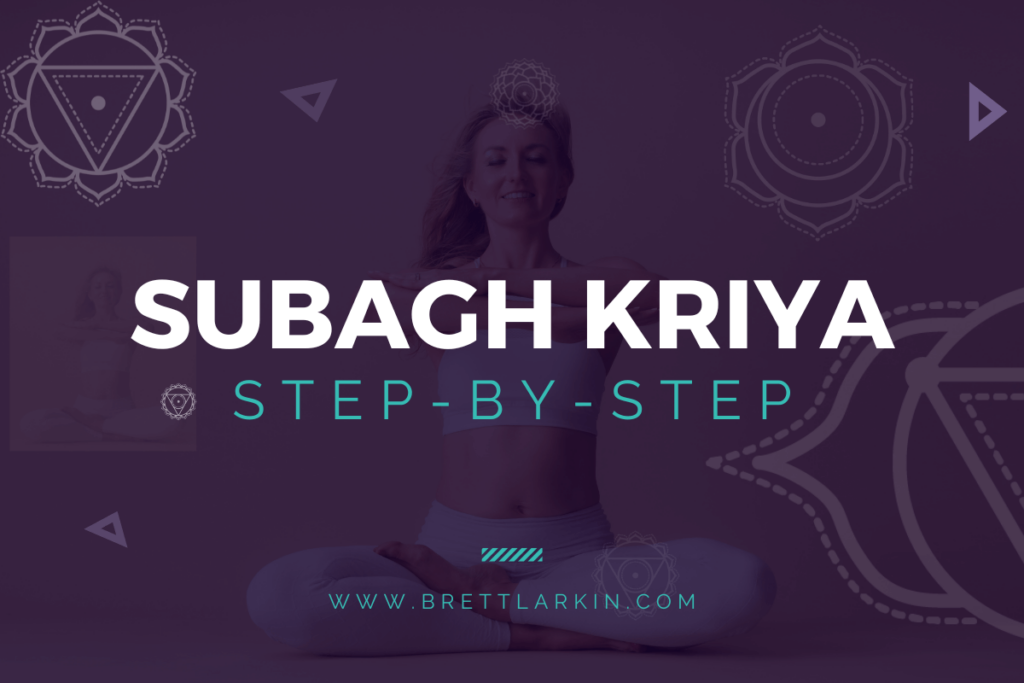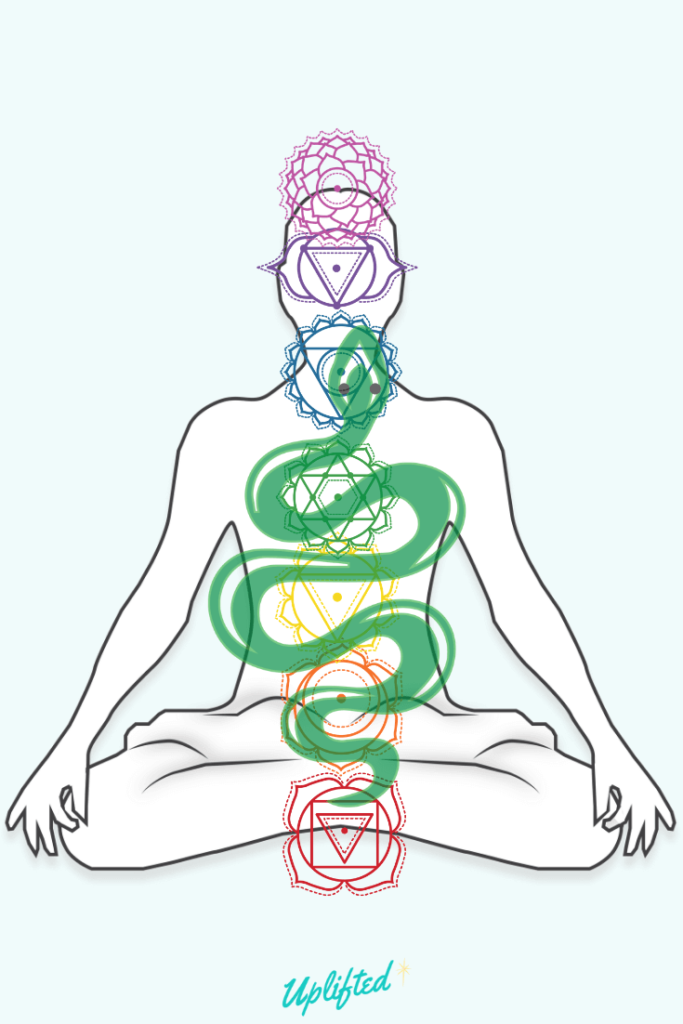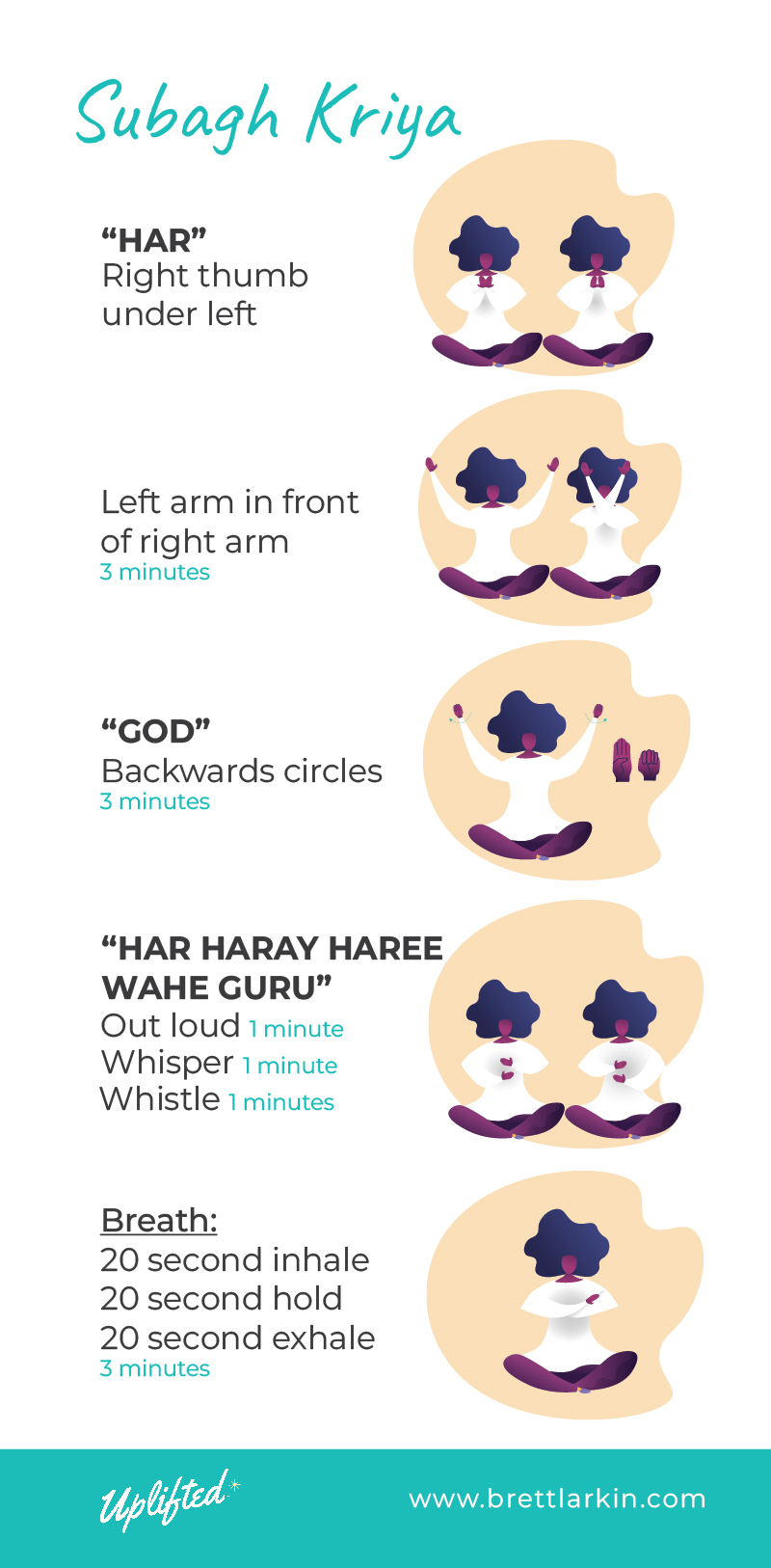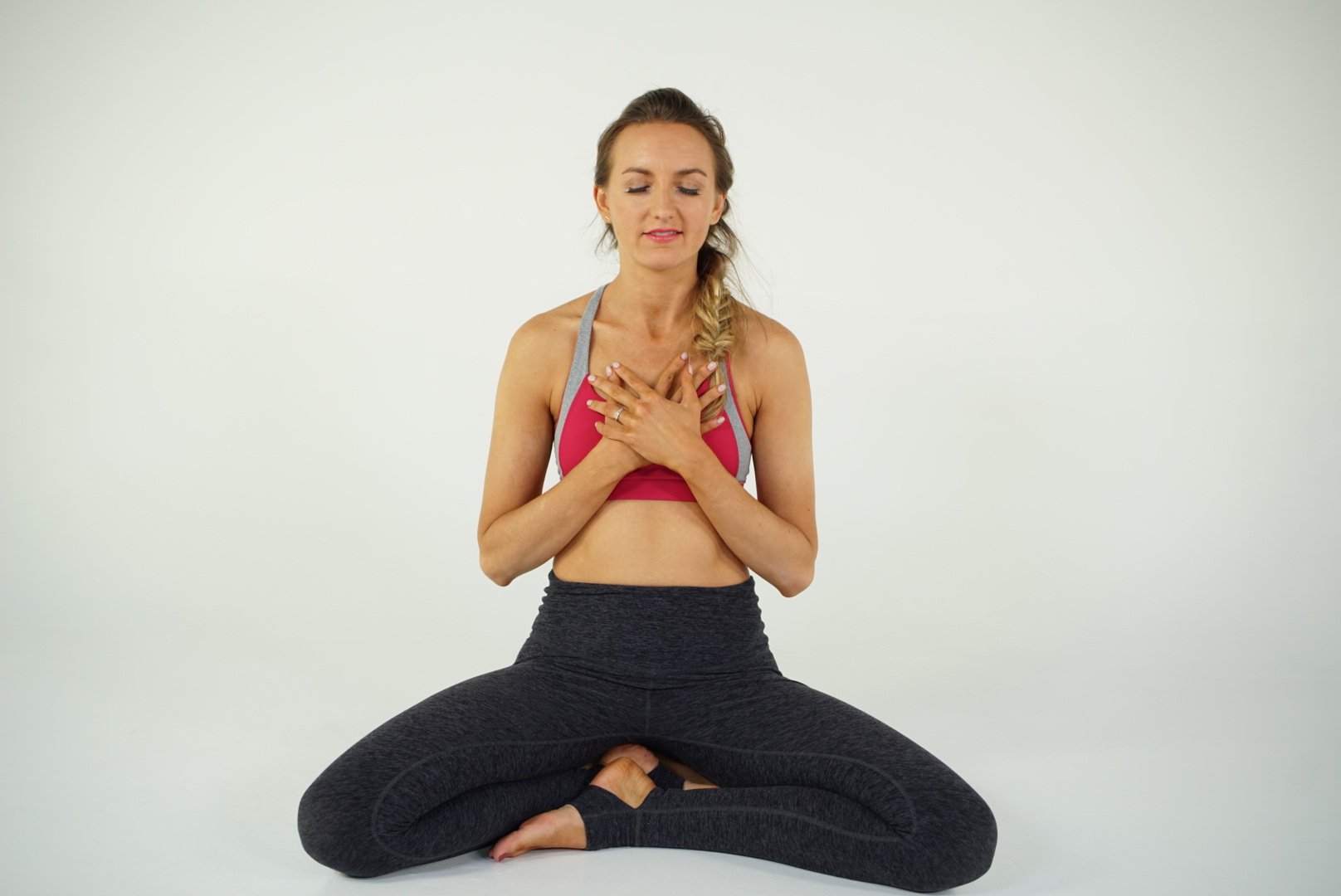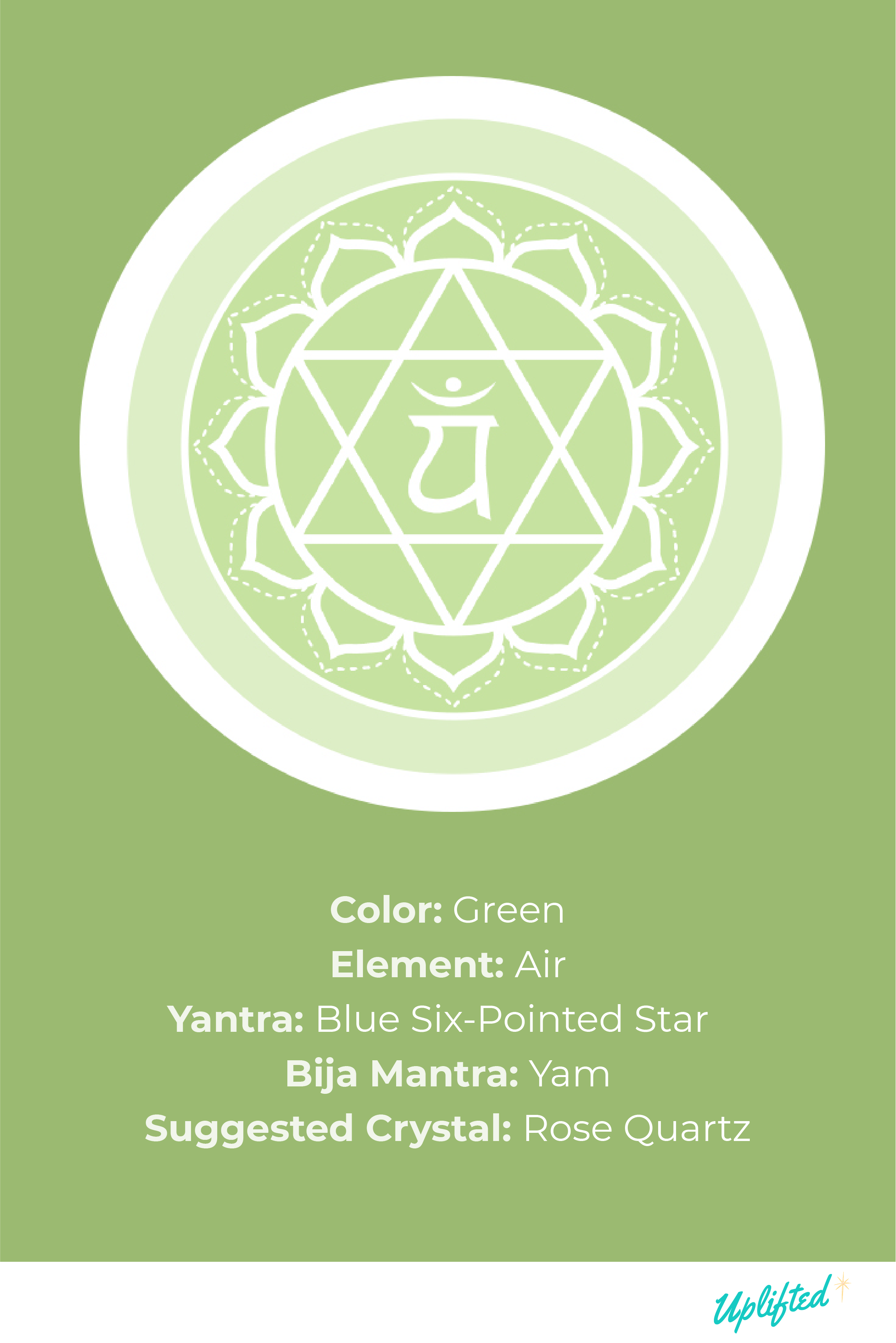Have you been feeling stuck lately? Maybe things haven’t really been going your way. You can’t catch a break? Well, you have come to the right place! I have a kriya to share with you that can make you a prosperity magnet!
It is called Subagh Kriya and it was first taught by Yogi Bhajan in 1996. Many people believe that this kriya is the most powerful and sacred in Kundalini Yoga.
Intrigued? I know I am!
What is Subagh Kriya?
The Sanskrit word ‘subagh’ translates to auspicious or prosperous. Subagh Kriya is believed to transform misfortune into prosperity and to enhance fortune and good luck. It is also believed to create wealth. It elevates your energy to attract more goodness into your life. Who couldn’t use more of that?
Benefits of Subagh Kriya
In Kundalini yoga, you work with energy in your body. Are you familiar with prana? Prana is Kundalini energy.
There is an orbital system in the body in which Kundalini energy exists and is constantly in motion. It originates at the base of your spine, at your Muladhara (root) chakra in a shape like a coiled snake. This energy moves up and down through your body in a loop. This loop is both vertical along the sushumna nadi and horizontal at the heart.
When you are born, this energy flows freely. Over time, life experiences can cause disturbances or blocks in this flow. Yoga is practiced to reduce and remove blocks to bring a balanced flow of energy back to the body. To return you to your highest self so that you can move through life in the clearest possible state.
Subagh Kriya is designed to strengthen and support your body to clear the “stuckness” and open your energy up to both receive and flourish.
Take my quiz to learn if YOUR kundalini energy is awakened 👇
How to do Subagh Kriya
Subagh Kriya is a five-part kriya. Each of the five parts is done for an equal amount of time, beginning at 3 minutes each, extended up to 11 minutes. If you are in need of a short version, part one, the Har Meditation for Prosperity, can be performed on its own.
Did you know that each finger on your hand relates to a planet in the solar system? This stems from the practice of palmistry, an art that can help you learn about yourself and peer into your future through the physicality of your hands. There isn’t a definitive record of where palmistry originated, but it is believed to have its roots in ancient India.
In Subagh Kriya, you will be working with a mudra that incorporates three specific areas of your hands:
- Your pinkies, which relate to Mercury and your way of thinking and communication.
- The base of your palms opposite your thumbs called the Moon mounds, relate to your imagination, emotions, and receptivity.
- Your index fingers, known as the Jupiter area of the hand, relate to your pride, ambition, expansion, and high ideals.
Ok! Now, on to the kriya.
Part One
Sit in easy pose with your spine straight and your chin slightly dipped down to lengthen your neck.
Elbows at your sides, raise your arms in front of you at a 45-degree angle. Your hands will be level to your throat. Hold each of your hands individually so that the fingers touch with a slight squeeze to maintain stability. Turn your hands so the palms face away from you and bring the sides of your index fingers together to touch. Thumbs cross below your palms, right thumb under your left.
Flip your hands to have your palms face you. Touch the sides of your hands together from the tops of your pinkies all the way down to the base of your palms.
Now that you’re familiar with HOW the hands will come into contact, let’s talk about the STRENGTH of that contact. As you bring the hands to touch in these positions, hit them hard. Your hands will likely shake a little from the contact. This force stimulates the areas of the hands that are the focus of this mudra.
Continue to alternately strike the hands in these two positions.
Maintain the focus of your eyes (while nine-tenths closed) on the tip of your nose.
Feel a bit like I’ve asked you to pat your head and rub your stomach at the same time?
Now, let’s incorporate the mantra.
Each time you bring the sides of your hands to touch, chant the mantra HAR in a deep monotone voice. When you chant HAR, touch the tip of your tongue to the top of your mouth. This will cause your R to trill and the sound that you create will sound like “hud.” As you chant HAR, focus on it emanating from your naval. Think of this like a slightly less intense breath of fire movement and pull your navel in with each HAR.
Guru Singh teaches in our Kundalini University 200-hour yoga teacher training that when you chant HAR with a trilled tongue it is energy that comes up from your core to your heart and then continues up to your tongue. As your tongue trills against your upper palate it then moves up to the limbic system of your brain which radiates the energy out through your body. It is a feel-good meditation that emanates the message that you feel good and feel open to receive.
How fast or slow should you go with this chant and mudra? You are your own best teacher and I think it is best to follow your own intuition and body as a guide. That being said, this meditation was originally taught to the rhythm of Tantric Har by Simran Kaur (listen to Tantric Har).
Are You Chanting Correctly? Refine Your Tune with Me! 👇

Are You Chanting Correctly? Refine Your Tune with Me!

Part Two
Stay in easy pose, close your eyes, and raise your arms up above your head in a V-shape (an angle of sixty degrees). Face your palms forward and spread your fingers open. Keep your fingers wide and strong.
When you exhale, keep your arms up, elbows straight, and cross them in front of you, left arm in front of right. On your inhale, return your arms to the open V-shape. Continue these arm crosses with each exhale. Alternate which arm goes in front each time.
This movement is also done to the rhythm of Tantric Har but this time you will not chant HAR out loud.
Part Three
Eyes remain closed. Keep your arms up at this sixty degrees angle. Fold your fingers over your thumb tightly into a fist. Squeeze as tightly as if you are trying to squeeze all the blood out of your thumb. Begin to move the arms in small backward circles with your arms. Keep the arms stretched and the elbows as straight as you can.
Chant the English mantra ‘God’ powerfully from your navel each time you make a backward circle.
The speed and rhythm of the movement and chant are the same as in the two previous movements.
Part Four
You’ve made it to part four and have earned the opportunity to give your arms a rest!
Bring your arms down so that your palms are in front of the center of your chest, facing your body. Position your right hand closer to your body. The left hand is about two inches farther away from your right hand and your body. Your arms are now parallel to the ground and your elbows are flared out to either side of you in a similar position as if you were locking arms with someone.
To begin, move your right hand up a few inches and move your left hand down a few inches. Return them to their starting position. This will move your hands over the space between your heart and navel center in a smooth motion.
The mantra for this part is HAR HARAY HAREE, WAA-HAY GURU (pronounced GUROO). Perform the chant from your navel as you move your hands. To give you an idea of speed, aim for one repetition of the mantra approximately every 4 seconds.
- If you have decided to practice each part for 3 minutes, chant the mantra out loud for 1 minute, whisper it strongly for 1 minute, and then whistle it for 1 minute.
- If you have decided to practice each part for 11 minutes, chant the mantra out loud for 6 minutes, whisper it strongly for 3 minutes and then whistle it for 2 minutes.
Part Five
Arms are shoulder level, parallel to the ground, with elbows out to your sides. Rest your right forearm on your left forearm with your palms facing down, just like the iconic pose from I Dream of Jeannie.
Sit tall with a straight spine. Keep your arms steady.
Close your eyes.
Breathe long and deep in this meditation. Do your best to complete one breath cycle per minute. Breathe in slowly for 20 seconds. Hold your breath for 20 seconds. Exhale for 20 seconds.
Alternatives to Subagh Kriya
Additional Kriyas
While Subagh Kriya is one of the more well-known prosperity kriyas in Kundalini yoga, it’s important to remember that nothing in life is one size fits all. Bodies are structured similarly but everyone has a uniqueness and different experiences and traumas that often make us receptive to practices in different ways. Luckily, there are many other exercises, kriyas, and meditations we can work with to invite more abundance into our lives.
Here are three of my favorite abundance kriyas and meditations from my library of free Youtube practices that I’ve created for you:
Work With Lakshmi
In yoga, the goddess Lakshmi is often associated with gratitude, abundance, and prosperity. By working with gratitude and cultivating it in your life, you increase your ability to recognize and engage with it.
Lakshmi is one of my favorite goddesses to work with. I’ve put together a whole challenge to help you form a relationship with all that she represents. Do my 18 Days of Abundance challenge to raise your energy with gratitude and prosperity.
Focus on Anahata
You can also work with anahata (heart chakra) to cultivate abundance. The Sanskrit word ‘anahata’ means unstuck. This chakra is associated with love, compassion, and joy.
When the heart chakra is balanced, feelings of compassion begin to fill you up. An open and balanced heart center supports joy and compassion to connect you to the world around you. You will feel more open to experiences and relationships. By strengthening this chakra you are better able to acknowledge and receive abundance as you come across it in your life.
Any backbend pose will be helpful to support an open heart center. If you are new to backbends, consider starting with Bhujangasana (Cobra Pose) and Setu Bandha Sarvangagasana (Bridge Pose). For the more advanced yogi (remember to warm up first!) try Dhanurasana (Bow Pose).
Contraindications of Subagh Kriya
When you practice Subagh Kriya, it is cautioned that you should not exceed 11 minutes per part, as this would be greedy and may have the opposite effect of what the kriya is intending. Those who do shall live under misfortune (so they say).
When you perform prosperity kriyas and heart-opener poses it is important to take time to ground yourself. Life and yoga are all about balance. Too much of any one thing can become a problem. Many Kundalini kriyas are designed to elevate and clear stagnant energy so a nice, long savasana (corpse pose) is a great way to settle.
Strengthen Your Relationship with Abundance
I know I have given you a lot to take in and think about. Trust that however you choose to work with the energy of abundance, it will be the right method for you. Experiment with what you feel drawn to and make adjustments when needed in order to fit your practice into your lifestyle.
Next Steps
- Love Kundalini? Refine your tune in (the Adi Mantra) with me in this free chanting masterclass.
- Experience my Kundalini Dance Party and elevate your mood in 8 minutes.
- Enroll in my Kundalini Demystified training course. Let’s demystify the “mystery” of this ancient science and INSTANTLY reap the benefits!
Get 3 Free Training Vidoes from our Kundalini University Experience & Certification Program
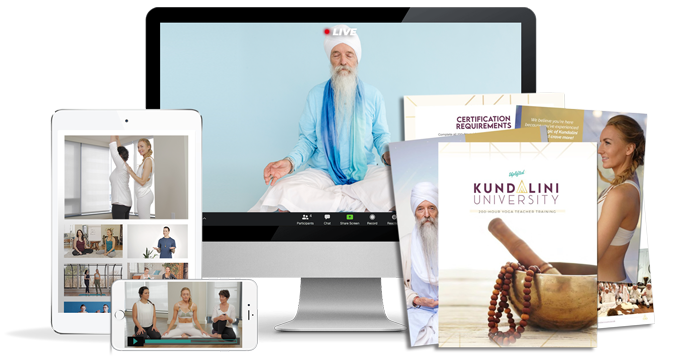
YOU MIGHT ALSO LIKE
- Ong Namo Guru Dev Namo: The Adi Mantra Explained [VIDEO]
- Kirtan Kriya: Kundalini Meditation That Will Make You Feel Better
- Sat Nam in Kundalini Yoga: Sanskrit Translation and Meaning
- Sat Kriya: A Yoga Practice You Can Do in 3 Minutes
- Shuni Mudra: The Seal of Patience
- Buddhi Mudra: What Is It And How Do You Use It?
- Adi Shakti Mantra: Manifest Your Divine Femininity
- Venus Mudra: The Seal of Clarity & Empowerment
- Why the Aquarian Sadhana Is The Ultimate Morning Yoga Practice
- The 7 Aquarian Mantras: Tune In To Profound Transformation
- What is Japji? The Sacred Ritual, Explained
- Chanting Mantras: Unlock the Secrets of These Spiritual Formulas
- 8 Kundalini mudras for health and energy
- How to Chant the Mangala Charan Mantra (With Pronunciation)
- The Kundalini Kriya For Elevation, Step-By-Step

